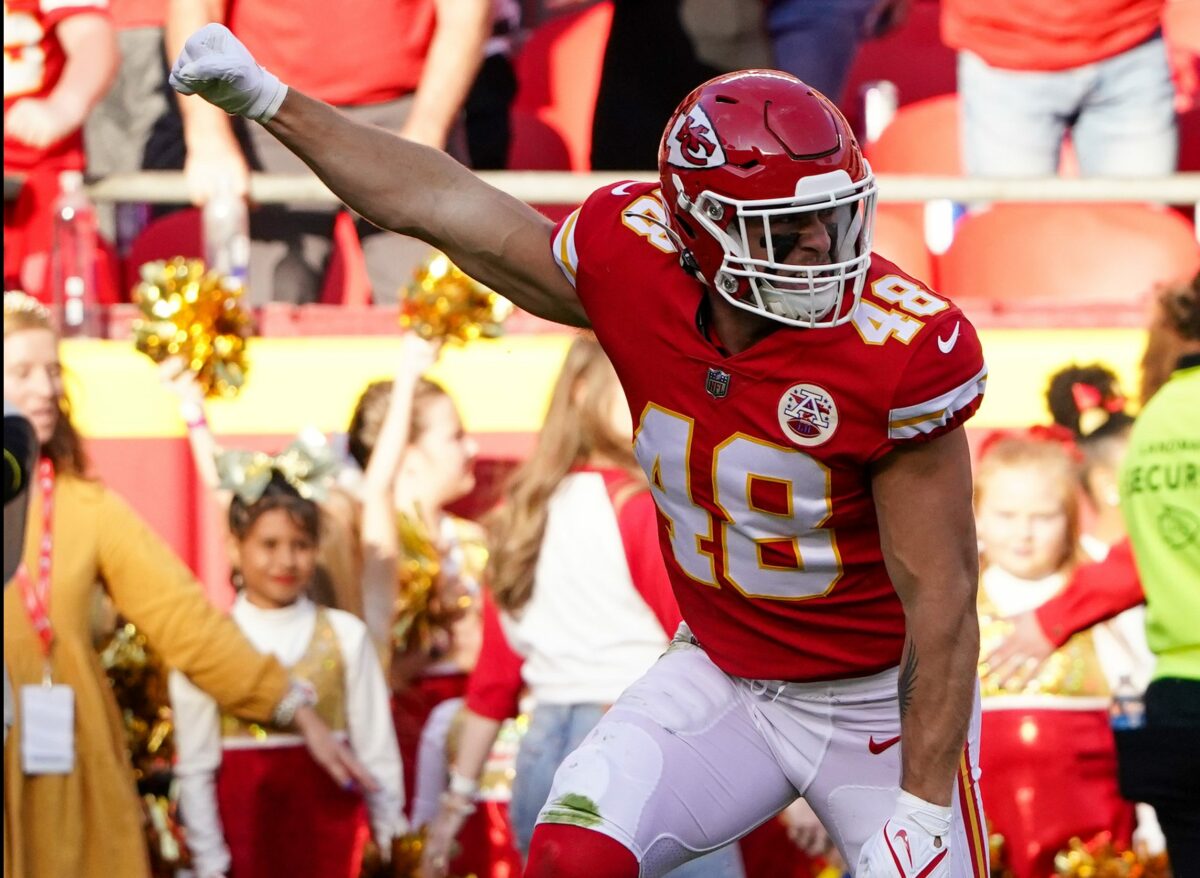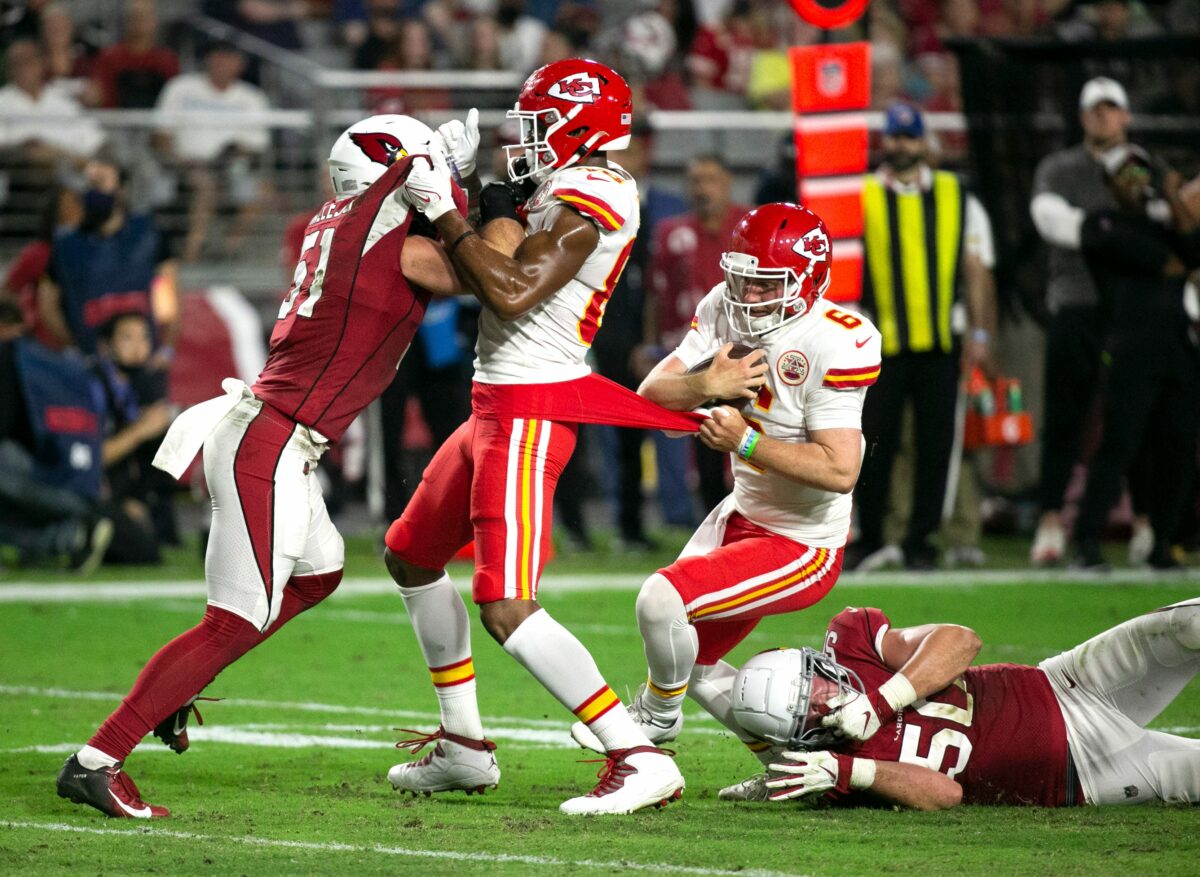The New Orleans Saints have a tough decision to make for pending free agent Taysom Hill, and other teams might make it only more difficult.
[jwplayer Lf98Hbuc-ThvAeFxT]
What are the New Orleans Saints going to do with Taysom Hill? As a pending restricted free agent, they have plenty of options. The Saints can either re-sign Hill to a long-term contract extension, let him walk away uncontested, or issue one of three different one-year tenders, each worth slightly more than the ones beneath it and fully-guaranteed against the salary cap. With five different restricted free agents to consider, the Saints must act quickly.
The lowest-level contract tender is estimated to cost about $2.1 million, and would give the Saints the right to match any contract offers Hill gets from other teams. The middle-tier tender is expected to be worth roughly $3.2 million, and would recoup a second-round draft pick for the Saints should they not match an offer sheet. The top-level tender will be somewhere around $4.6 million in value and brings back a first-round pick if Hill leaves.
That makes the second-round tender the smart choice. One of several things would happen:
- Hill receives no offers, and plays the 2020 season on a below-market $3.2 million (estimated) salary cap hit
- Hill receives an offer, which the Saints match, and keep him around long-term on whatever his market value is
- Hill receives an offer, and the Saints decline to match, replacing the second-round pick they lost in last year’s draft-day trade
Right now, it’s unclear what Hill’s value will be on the open market. If teams view him as a backup quarterback with starter’s upside, he should be worth about $7.5 million per year (like Ryan Tannehill, Teddy Bridgewater, and Case Keenum). If he’s perceived as an Andy Dalton-esque mid-level starter, that number climbs to $16 million per year. Even low-level backups like Chase Daniel, Ryan Fitzpatrick, and Tyrod Taylor are getting $5 million per year or better.
But that assumes his future really lies at quarterback. Despite the Steve Young comparisons floating around, Hill’s best work comes everywhere but quarterback. He caught as many touchdown passes in the 2019 regular season as passes he’s completed in his career (6). He’s a very fun player, but his talents are best used elsewhere.
And the clock is ticking on how much longer he’ll have the athleticism he’s thrived with recently. Hill turns 30 later this year and has a lengthy injury history from his college days, though he’s managed to avoid damaging hits so far in the NFL. He could look like a very different (and much more limited) athlete in just three or four years, and he hasn’t shown the passing ability to compensate for it.
So what could his contract look like if he continues to play such a nebulous position, listed at quarterback but doing everything else? The low end might be San Francisco 49ers fullback Kyle Juszczyk, who similarly blocks, runs, and catches while earning $5.25 million per year. The Detroit Lions just paid backup tight end Jesse James $5.65 million per year, while starters like Trey Burton ($8 million), Jared Cook ($7.5 million), Tyler Higbee ($7.25 million), and Jack Doyle ($7.1 million) each set a hypothetical lead for Hill to chase. His ability to throw and play special teams should only raise that bar.
It all shapes up for another difficult road to arbitration not unlike the Jimmy Graham franchise tag dispute that once dominated an offseason. Even if the Saints successfully keep Hill around for 2020 on a tender (at whichever level suits you), this is an obstacle they’ll have to overcome sooner or later. Better to let other teams make Hill an offer and decide what his market value is, and then choose whether it’s a price the Saints are willing to pay.
Teams will not give up a first round pick for a 30-year-old, maybe-quarterback. But there are several franchises that could justify giving up a second-rounder, like the Indianapolis Colts (who have two picks in the second round, at Nos. 34 and 44), Miami Dolphins (picking at Nos. 39 and 56), Seattle Seahawks (Nos. 59 and 64), and even the Atlanta Falcons (Nos. 47 and 55). Any of those teams could have varying degrees of interest in Hill as a quarterback, tight end, or versatile weapon like the Saints currently use him.
And any of those picks is worth more to the Saints than what he’s currently doing. They could use a second-rounder to help land a real developmental passer who, unlike Hill, has time to grow and play a long time (like 21-year-olds Jordan Love or Jalen Hurts). Or they could pick up badly-needed receiving help who won’t need to be schemed touches, and can beat opponents outright for the next decade (such as tight end Thaddeus Moss, or wide receivers Justin Jefferson and Brandon Aiyuk).
This is an opportunity for the Saints to gain more certainty and answer some questions, regardless of how badly it would upset Hill’s biggest fans. And that’s understandable: he hasn’t let anyone down yet. He’s caught every pass and converted every first down and lucked out with some great adjustments by his receivers on a couple of ugly passes deep downfield. But the law of averages suggest that at some point he’ll regress, and the Saints would do better to move on too soon than invest too much in him too late.
All of this in mind: we don’t know what’s going to happen in March. The Saints could very well value Hill so strongly that they anchor themselves to him with the first-round tender, or even a contract extension. They could also pinch pennies and risk a right-of-first-refusal tender, which would recoup no draft picks if he leaves. It’s risky, but the second-round tender is a happy medium that doesn’t cost much but promises many of the same results as the most-expensive level option.
So here’s our proposal. What would you choose? Matching a contract offer in the range of four years and $33 million, or a draft pick in the first half of the second round, and the cheap four-year rookie deal that comes with it? This is the sort of problem the Saints must grapple with in the months ahead.
[vertical-gallery id=26750]






